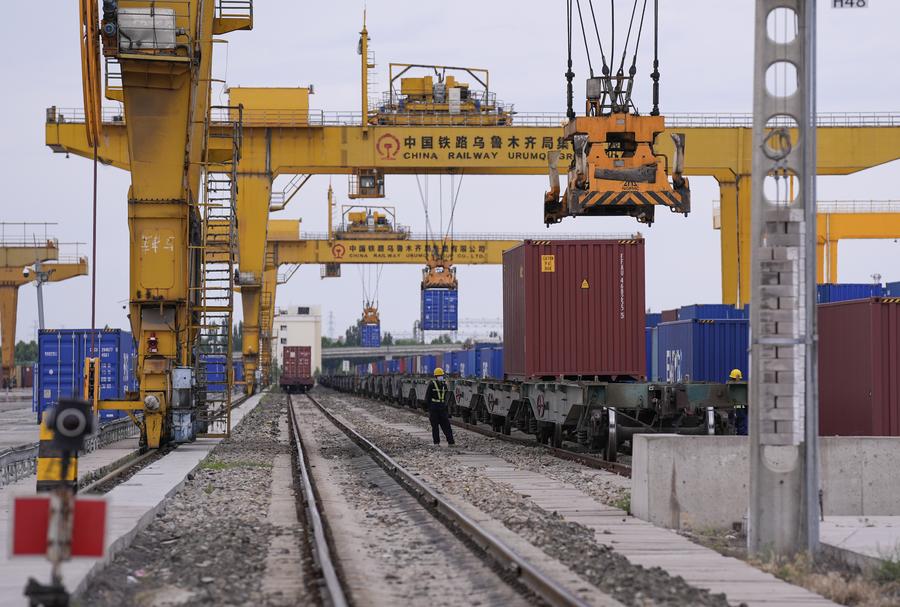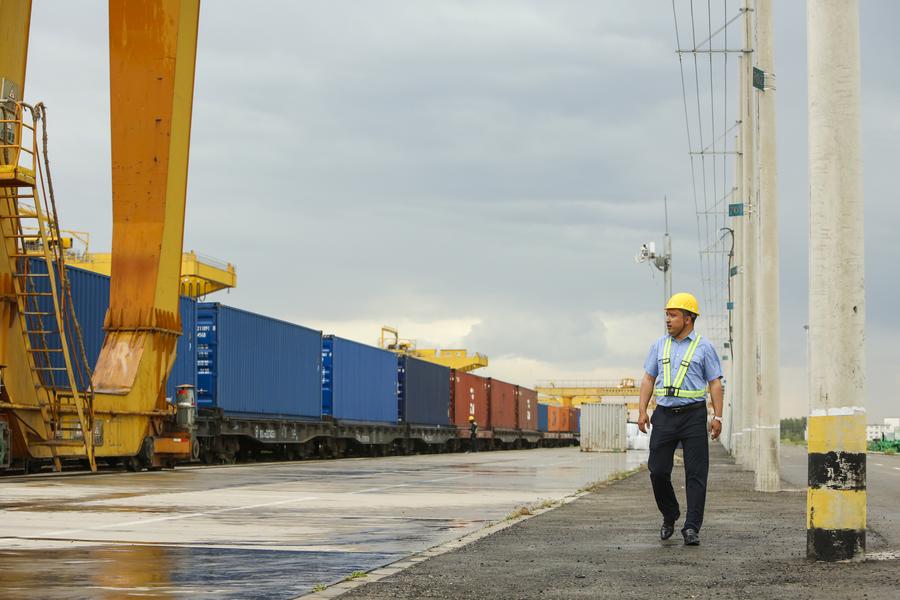Guardians of China-Europe freight trains at Horgos railway port

This photo taken on May 29, 2024 shows a view of the load-transfer yard of Horgos railway port in Horgos, northwest China's Xinjiang Uygur Autonomous Region. (Xinhua/Wang Fei)
URUMQI, June 2 (Xinhua) -- At the railway port of Horgos, a group of frontline workers endeavor with firm determination on a daily basis. Though their efforts may go unnoticed by many, these workers play a crucial role in ensuring the smooth operation of China-Europe freight trains.
Horgos is one of the major railway ports in northwest China's Xinjiang Uygur Autonomous Region. As the Belt and Road Initiative (BRI) continues to forge ahead, Xinjiang has committed to building itself into an important corridor linking Asia and Europe and to serving as a gateway for China's opening-up efforts in the west.
A flagship project and iconic brand of the BRI, the China-Europe freight train service has become the "golden corridor" of trade between Asia and Europe. These dedicated workers at Horgos railway station contribute their unwavering commitment and professional skills to ensure the safe operation of these trains.
CARGO SAFETY GUARDIAN
Yelrik Duysanbe's roots are planted in the pastoral landscapes of his upbringing. Raised in a herding family, trains for him represent more than just a mode of modern transportation. In addition, they embody a vital connection linking Yelrik's world with bustling cities beyond.
In 2019, fresh from university, Yelrik embarked on a new chapter, joining China Railway Urumqi Group Co., Ltd. as a freight inspector at Horgos railway station. His role revolves around ensuring the safety of cargo by meticulously inspecting loading procedures, thereby promoting the secure transit of goods aboard China-Europe freight trains.
"The most crucial and challenging aspect of our work lies in ensuring the proper securing of container latches," Yelrik noted. "Any oversight could spell disaster, endangering both cargo and personnel. Thus, we approach this high-risk task with utmost care and attention."
Despite the mounting pressure of increased train traffic, Yelrik finds comfort in the silver lining of elevated earnings. "Over the years, my income has seen a steady uptick, growing by a remarkable 10 percent annually," he said.
Faced with an increasing workload, Yelrik and his colleagues continuously explore novel solutions, refine processes, upgrade equipment and enhance efficiency.
"Our journey mirrors that of the China-Europe freight trains -- marked by steady progress and growth," he commented.
Clad in his work uniform, Yelrik often draws curious gazes from people eager to learn more about his role at the Horgos railway station. This attention amounts to just a hint of celebrity. He often explains patiently, elucidating the functions and significance of China-Europe freight trains.
"The impact of China-Europe freight trains extends beyond the confines of the port station, elevating the prominence of the entire port city," he said. It is this transformative effect that inspires Yelrik to remain in this role, contributing to the success and development of the westernmost port station in the country.
SAFE SHUNTING SENTINEL
Kurkin Mamuleti, 29, serves as a crucial member of the shunting team at Horgos railway station. Tasked with meticulously disassembling and reassembling trains, he navigates the complexities of ensuring safe transit of cargo bound for diverse destinations. Even the slightest error could jeopardize the safety of the train and pose risks to personal safety.
The vast expanse of Kurkin's workplace spans over 1 million square meters, surpassing the size of 140 football fields.

Kurkin Mamuleti works at the Horgos railway port in Horgos, northwest China's Xinjiang Uygur Autonomous Region, Jan. 16, 2024. (Xinhua/Zhao Ge)
His daily duties involve enduring scorching summer temperatures nearing 40 degrees Celsius and biting cold of minus 28 degrees Celsius in the winter months. Around the clock, his team works tirelessly to ensure the safety of trains, cargo, and personnel at the station.
"As a frontline worker, I deeply feel the weight of responsibility upon my shoulders. Collaborating closely with my fellow shunting team members, I strive to execute each operation with precision and efficiency, safeguarding the integrity of the China-Europe freight trains," he said.
"We harbor hopes for the continual expansion and advancement of the China-Europe freight trains. As a gateway to the west, we aspire to contribute to their development right here in Horgos, a prospect that fills us with profound pride and determination," Kurkin added.
PORT EVOLUTION WITNESS
Hamit Turgun has been part of the Horgos railway port team for a decade, seeing the port change right in front of him. When he started working at the port in 2013, there were no China-Europe freight trains, and traffic was sparse, with only a couple of trains passing through each day.

This photo taken on May 14, 2023 shows Hamit Turgun checking the crane operation conditions at the Horgos railway port in Horgos, northwest China's Xinjiang Uygur Autonomous Region. (Xinhua/Hao Zhao)
Because of rail gauge differences between Kazakhstan and China, goods have to be switched at the station. Hamit and his team take care of this important job, making sure everything runs smoothly.
"In the beginning, the port was quiet, with just a few trains. But now it's bustling. We have over 20 trains coming through every day," said Hamit. He proudly mentioned that the total number of freight train routes passing through the Horgos railway port has reached 81, connecting it to 18 countries.

This photo taken on May 14, 2023 shows Hamit Turgun patrolling the Horgos railway port in Horgos, northwest China's Xinjiang Uygur Autonomous Region. (Xinhua/Hao Zhao)
At the same time, he's also seen the types of goods carried on the China-Europe freight trains grow in variety to reach over 200, while in recent years, he's noticed an increase in the number of new energy vehicles and high-end machines being exported.
"In the coming years, if things keep going like this, I think the Horgos port could become the busiest in Xinjiang, maybe even one of the busiest in China," said Hamit. "Over the past ten years, I've seen the port grow, and I'm excited about what the future holds."
Photos
Related Stories
- Interview: BRI stabilizes China-Europe trade, transport, says rail CEO
- Expanding China-Europe freight train service boosts trade, prosperity
- China-Europe freight train trips surpass 90,000
- China-Europe freight train service connects northern Chinese port, Moscow
- Experts hail fruitful results of Xi's visit
Copyright © 2024 People's Daily Online. All Rights Reserved.









